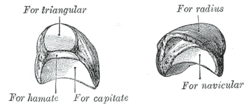Lunate bone
| Lunate bone | |
|---|---|

Left hand anterior view (palmar view). Lunate bone shown in red.
|
|

The left lunate bone
|
|
| Details | |
| Articulations |
radius proximally capitate and hamate distally scaphoid laterally triangular medially |
| Identifiers | |
| Latin | os lunatum |
| MeSH | A02.835.232.087.144.663 |
| TA | A02.4.08.005 |
| FMA | 23712 |
|
Anatomical terms of bone
[]
|
|
The lunate bone (semilunar bone) is a carpal bone in the human hand. It is distinguished by its deep concavity and crescentic outline. It is situated in the center of the proximal row carpal bones, which lie between the ulna and radius and the hand. The lunate carpal bone is situated between the lateral scaphoid bone and medial triquetral bone.
The lunate is a crescent-shaped carpal bone found within the hand. The lunate is found within the proximal row of carpal bones. Proximally, it abuts the radius. Laterally, it articulates with the scaphoid, medially with the triquetral, and distally with the capitate. The lunate also articulates on its distal and medial surface with the hamate bone.
The lunate is stabilised by a medial ligament to the scaphoid and a lateral ligament to the triquetrum. Ligaments between the radius and carpal bone also stabilise the position of the lunate, as does its position in the lunate fossa of the radius.
The proximal surface of the lunate bone is smooth and convex, articulating with the radius. The lateral surface is flat and narrow, with a crescentic facet for articulation with the scaphoid. The medial surface possesses a smooth and quadrilateral facet for articulation with the triquetral. The palmar surface is rough, as is the dorsal surface. The dorsal surface is broad and rounded. The distal surface of the bone is deep and concave.
The lunate receives its blood supply from dorsal and palmar branches.
The lunate has a variable shape. About one-third of lunate bones do not possess a medial facet, meaning they do not articulate with the hamate bone. Additionally, in about 20% of people, blood supply may arise from palmar vessels alone.
...
Wikipedia
